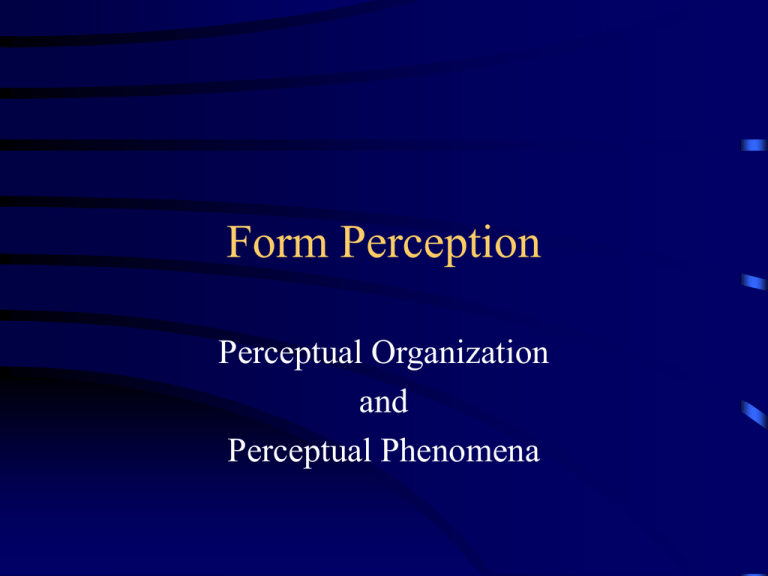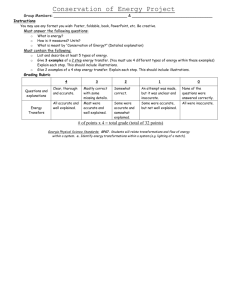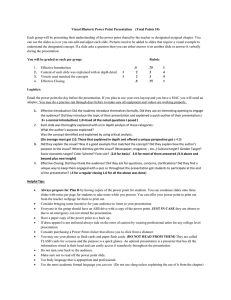Form Perception
advertisement

Form Perception Perceptual Organization and Perceptual Phenomena Perceptual Organization • • • • • From Gestalt psychology c1930 Law of Prägnanz (“good configuration”) Wertheimer 1958 -- “laws of grouping” Grouping laws are corollaries to Prägnanz Not much explanation given for these -Gestalt theorists like to think they are innate • Opponents like to argue that it’s all learned The Grouping Laws • • • • • • • Proximity Similarity Orientation Closure Good continuation Common Fate Familiarity Proximity • The visual system groups things which are close together Similarity • Objects of similar shape, intensity, or color are grouped together OOVVOO VVOOVV OOVVOO VVOOVV OOVVOO OOOOOOOOOO OOOOOOOOOO OOOOOOOOOO OOOOOOOOOO OOOOOOOOOO Orientation • The visual system groups items with common orientation Closure • We tend to fill out incomplete details to form “good figures” Good Continuation • The visual system prefers C1 continuity Figure Preferred interpretation Other possible interpretation Common Fate • Items with common motion are readily grouped Example: Hidden Birdie Familiarity • You will undoubtedly see more than random specs in this picture below due to your familiarity with the subject. Familiarity • …but this probably looks pretty random to most of you Familiarity (or lack thereof) • The word “recognition” in Chinese characters: “Modern” Theories • Fourier based – Campbell & Robinson 1968 • Autocorrelation – Uttal 1975 • Network models – Grossberg 1976, Leake and Anninos 1976, Sejnowski 1976 • Texons – Julesz 1965, 1975, 1981 From Caelli, Terry. Visual Perception: Theory and Practice, Pergamon Press, 1981 Form Phenomena • • • • • • • • Müller-Lyer Horizontal-Vertical Poggendorf Titchener Kanisza Ouchi Baxter-Harris?? Adaptation examples Müller-Lyer (1889) • Which line is longer? Müller-Lyer Explained • In first version, perspective is common explanation: • In second, we need a different explanation – Feedback from eye scanning back and forth? – Nope. Lines presented tachistoscopically (really fast) still exhibit effect. • Interpreting whitespace as part of line? • Many other theories have been proposed... Horizontal-Vertical • Which line is longer? Horizontal-Vertical Explained • The bisection is important -- no illusion if segments joined at endpoints. ( i.e. |_ ) • Some say illusion only works with bisector horizontal (works either way for me, though) • Largest effect is actually for a line 20° off the vertical (Cormack & Cormack 1974) • Perspective effect? (Kunnapas 1957) • Greater length of horizontal FOV vs vertical? Titchener • Which red dot is bigger? Art: Bob Ausbourne Titchener Explained • Brain accentuates contrasts – Small dot among big dots becomes smaller – Big dot among small dots becomes bigger Poggendorf (1860) • Do the segments line up? Interactive Demo Poggendorf Explained • Blakemore (1973) attributes this to "tilt contrast," caused by lateral inhibition between neural signals of orientation, which will expand the appearance of acute angles. • Explains some other illusions • But doesn’t explain Poggendorf adequately – No effect with just acute angles – but do get it with just obtuse angles Kanisza (1979) • How many triangles? • Illusory contours a.k.a. subjective contours Kanisza Explained • Gestalt dudes say simple:“law of Prägnanz” – Simplest interpretation is a white triangle occluding simple geometric figures. Ouchi The effect may be heightened if you read these words while paying attention to what is happening with the circle in your peripheral vision Ouchi Explained • Inset perceived as being at different depth? • “a failure to integrate two motion signals into a single motion vector which characterises rigid motion” (Hine, Cook, and Rogers 1995 p. 3093) • An artifact of “biased flow estimation” (Fermüller, Pless and Aloimonos 1998) http://www.cfar.umd.edu./ftp/TRs/CVL-Reports-1998/TR3917-fermuller.ps.gz Baxter-Harris?? • Note the black rectangular outline of the figure. Baxter-Harris Explained • Scientists are baffled by this latest discovery. Adaptation to Intensity Disappearing Blobs Explained • Normally saccades keep edges “alive” • With gentle intensity gradient, though, saccades are not large enough to re-trigger edge detectors Adaptation to Frequency Adaptation to Frequency Response from frequency detectors for a pattern of particular frequency - + Looking at a high freq pattern causes these detectors to fire with the strength indicated = Normally looking at a medium freq pattern would result in this response But the high freq detectors are tired and don’t fire as much as usual. So you perceive a lower frequency than actual Face Recognition • • • • Neonates of < 1yr can do it Special “face” cells in cortex for it Studies of prosopagnosic patients revealing Identity, familiarity, expression, sex all processed separately in parallel • Faces seem to be stored as diffs off of a prototype, but using what bases? From Bruce (Ed.), Face Recognition: a special issue of the European Journal of Cognitive Psychology, 1991 Face Recognition • You might recognize this face… • Often as few as 18 pixels is enough to identify a face • Monkey “face” cells fire for both high- and low-pass filtered faces Bibliography • • • • IllusionWorks http://www.illusionworks.com The Joy of Visual Perception http://www.yorku.ca/eye/ Sandlot Science http://www.lainet.com/~ausbourn/ UIUC Internet Psych Lab, Visual Perception http://kahuna.cogsci.uiuc.edu/ipl/vis/level_2_vis.html • MIT Encyclopedia of Cognitive Science http://mitpress.mit.edu/MITECS/ • Wientraub & Walker, Perception, Wadsworth Publishing Co, Belmont,CA. 1966 Bonus “rule of thumb” • The fovea covers only about 2° of visual angle: roughly the area of the thumbnail at arm’s length. From Churchland and Ramachandran, Perception (Atkins, Ed.), Oxford Univ. Press, 1996 Sean Ho is next with more form perception... Stay tuned!




